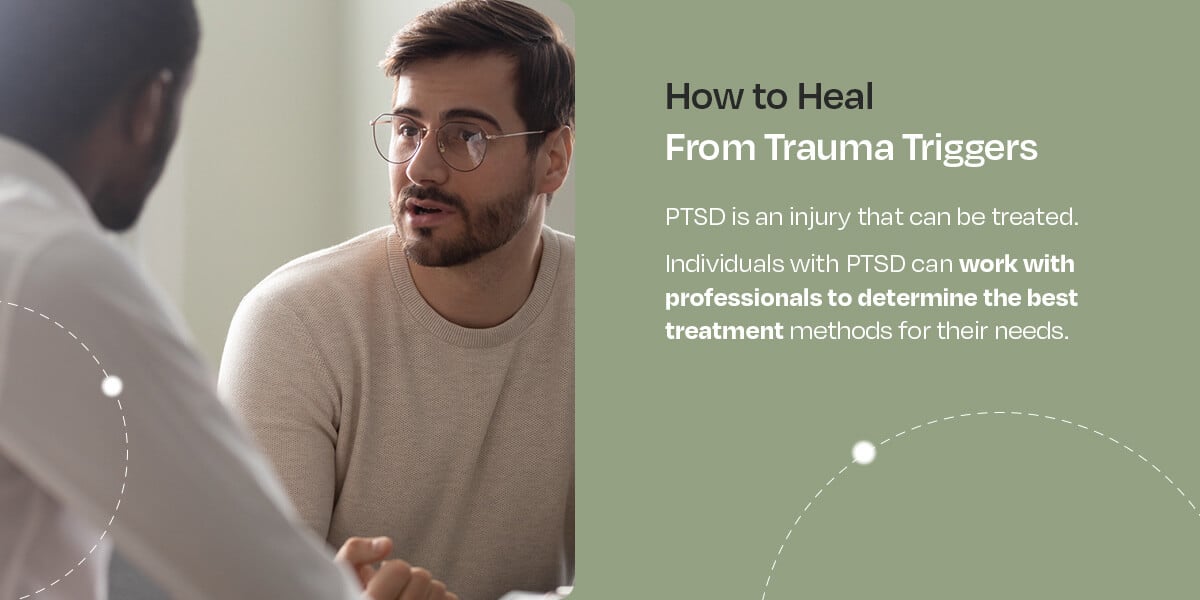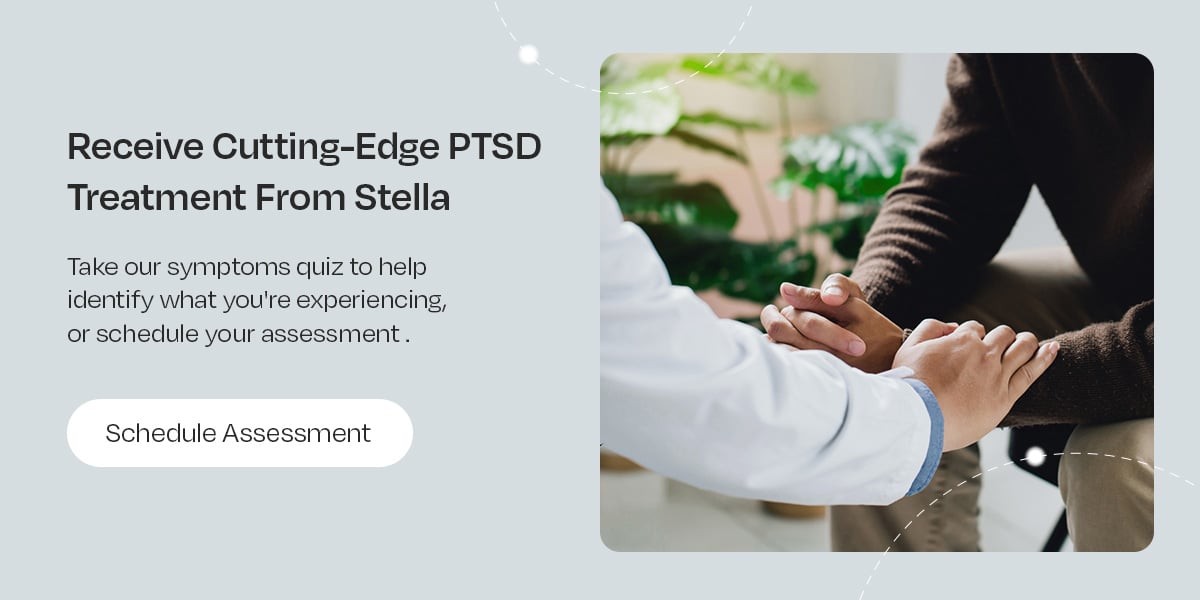Common PTSD Triggers: A Guide

The following article refers to PTSD (Post-Traumatic Stress Disorder), whereas at Stella, we use the term PTSI (Post-Traumatic Stress Injury). We encourage you to adopt this language to break the stigma against Post-Traumatic Stress. Read more about the shift from PTSD to PSTI here.
Dealing with triggers from trauma is easier with understanding and support. Recognizing PTSD triggers helps individuals manage symptoms and gain better control. PTSD trigger examples include images, noises, scents, tastes, weather conditions and colors.
If you think you may be suffering from PTSD, we encourage you to take our symptoms quiz here.
What Is PTSD?
PTSD is a mental health challenge that individuals can develop after experiencing traumatic events or ongoing stressors–the continuous sources of stress with a sustained presence, like persistent work pressures, lingering health issues, or constant financial strains. . A traumatic event can be any frightening, dangerous or shocking situation. Experiencing the body's fight-or-flight response during a potentially dangerous situation is common, but PTSD causes individuals to continue experiencing symptoms long after a dangerous situation ends.
What Are Common Triggers for People With PTSD?
Understanding and recognizing common PTSD triggers helps individuals avoid potential stressors, manage symptoms, and seek support when necessary. Triggers vary from person to person, but it's important to recognize the following common types of trigger examples, including those for PTSD:
Images
Certain images can remind individuals of a traumatic event and trigger symptoms. Consider the following images that can trigger PTSD:
- Video footage or online images: A person may experience PTSD symptoms when seeing news footage or online images of a like-minded event similar to theirs, such as hate speech, neglect, a war zone, or a car accident.
- Physical features: Visual triggers may include physical features resembling a perpetrator in a traumatic event. For example, a person may experience symptoms when encountering someone resembling the person who caused interpersonal violence, an old boss, or a bully from their past.
- Objects: Seeing objects such as weapons, cars, medical equipment and clothing can trigger symptoms. Objects that trigger PTSD are typically items involved in a traumatic event. For example, a person may smell a scent tied to a stressful period in their life or see a shirt they wore the day during a traumatic event.
Identifying your triggers and ongoing stressors is the first step. Beyond that, you can take steps to mitigate how often you encounter certain visual triggers. For example, there are certain websites that curate lists of possible triggers found in movies and TV shows — consider performing a quick search on one of these databases before jumping into your next watch.
Noises
Loud noises like yelling can trigger PTSD. When a traumatic situation involves loud sounds, such as a concert, parental verbal abuse, or combat, people can be triggered when similar noises occur. A loud noise may cause an individual to experience flashbacks, distressing thoughts, sweating, a racing heart, difficulty concentrating, panic, aggression, or risky behavior. Noise is a common war PTSD trigger because of the sounds that soldiers hear in combat.
Prepare yourself for sound-related triggers by always carrying a pair of earplugs or earbuds with you to block out the noise or distract you with music or a podcast. Many people have difficulty with the sound of fireworks — keep a calendar of local events that may display them so you're not caught off guard.
Tastes and Smells
An individual may also experience PTSD symptoms due to certain tastes or odors reminding them of traumatic experiences. For example, the smell of smoke may trigger a person who survived a house fire. Individuals with PTSD from childhood trauma may experience symptoms when tasting foods frequently eaten as a child. The sensory nature of tastes and scents can evoke vivid recollections of a traumatic event.
It's hard to predict or avoid certain sensory experiences. Work on developing a set of grounding techniques that can help stabilize you during these moments. For example, deep breathing exercises send more oxygen to the brain and stimulate the parasympathetic nervous system to signal that a situation is safe. It can help a person come out of their flight-or-flight response and feel calmer when triggers arise.
Another helpful way to manage these triggers is to carry something with you to counteract the taste or smell. For example, if the smell of smoke triggers you, you can rub fragrant lotion on your hands to smell instead. Gum or mints are helpful in the case of taste triggers.
Weather
Weather conditions can trigger PTSD symptoms in individuals who experienced natural disasters such as tornadoes, floods, hurricanes, volcanic eruptions, fires and earthquakes. A person may exhibit PTSD symptoms when experiencing heavy rain, strong winds, thunder or lightning.
The sights and sounds of weather conditions can remind people of past natural disasters and make them feel like the event is occurring again. Exposure to extreme weather can also increase the chances of individuals experiencing mental health challenges such as PTSD and anxiety because it increases stress.
Consider downloading a weather app that sends notifications when the weather forecast changes. Pay attention to all facets of the week's weather predictions, including the temperature, moisture level, cloud cover and other conditions that may be cause for concern. Try to incorporate indoor plans on days when weather triggers are unavoidable until you feel confident you can withstand them. Avoid consuming too much media coverage of natural disasters and mute any news apps if a certain event is too challenging to engage with at this stage in your healing.
Colors
Similar to other PTSD triggers, colors can remind individuals of troubling experiences in their past. For example, a person may experience negative emotions when seeing the color red if it was a favorite color of an ex who emotionally abused them.
Color psychology can also play a role in how individuals experiencing PTSD react to certain stimuli. For example, someone may find that red evokes intense emotions such as urgency, alertness, anger and aggression. Excessive exposure to this color may cause people with PTSD to feel distressed, while exposure to non-triggering colors could evoke feelings of calmness and serenity. A therapist can help you work through your relationship with certain colors and develop a plan to regulate the emotions associated with them.
What to Do When Past Trauma Is Triggered
Understanding PTSD triggers is the first step toward healing and improved symptom management, but knowing how to deal with PTSD triggers is essential. When an image, sound, smell, taste, weather condition or color triggers an individual, the following coping techniques can help with symptoms:
- Seek professional help: Professional treatments such as talk therapy and ketamine infusion and integration sessions can help individuals recognize personal triggers and manage PTSD symptoms for greater control over their lives.
- Seek support from others: Joining support groups allows individuals to receive support from others with similar experiences. People who have PTSD can also seek emotional support from loved ones.
- Incorporate physical activity: Physical exercises such as running, weight training, dancing, swimming and walking can help people decrease stress hormones and produce endorphins, creating a sense of calm.
- Engage in mindfulness: Engaging in mindfulness techniques can help individuals stay present in the moment and better manage overwhelming emotions.
- Write or journal about intense feelings: Writing is an effective way to process intense thoughts and emotions.
- Practice self-control: Allowing oneself to feel and acknowledge emotions while controlling reactions to these emotions is important. Individuals can use coping mechanisms to control reactions to anger and other strong emotions. Talk therapy is an excellent way to learn about healthy coping mechanisms and how to implement them.
How to Heal From Trauma Triggers

PTSD is an injury that can be treated. Individuals with PTSD can work with professionals to determine the best treatment methods for their needs. Consider the following ways people can work toward healing from PTSD:
- Ketamine infusion and integration sessions: This ketamine treatment uses an NMDA receptor antagonist to help neurons communicate on new pathways and improve a person's mood.
- Dual sympathetic reset: Dual Sympathetic Reset (DSR) is an advanced Stellate Ganglion Block (SGB) treatment that can help regulate the sympathetic nervous system and reduce involuntary functions associated with PTSD, such as sweating and increased heart rate.
- Trauma-informed therapy: Trauma-informed talk therapy helps individuals work toward positive outcomes while healing from PTSD. An experienced mental health professional can help people with PTSD understand their triggers and how to cope.
- Regular self-care: Individuals with PTSD should focus on eating healthy foods, getting adequate sleep and exercising regularly.
- Consistent routines: Consistent routines can help individuals manage their mental health and PTSD symptoms. People experiencing PTSD should create regular routines that include self-care tasks and daily enjoyable experiences.
Dealing With PTSD Triggers at Work
Creating a trigger-aware workplace is important because PTSD symptoms can arise anytime. Employees with PTSD who feel supported can focus on work without fear of experiencing triggers. Individuals can help reduce workplace PTSD triggers by communicating their needs to employers and supervisors.
Leaders should offer support by decreasing triggers wherever possible. For example, an employer can provide headphones or a quiet work environment with minimal noise distractions if sound triggers an employee. Employees can also manage symptoms with the following tips:
- Take breaks when necessary: Short breaks to practice deep breathing or meditation can help individuals manage PTSD symptoms at work.
- Move around: Brief movements can also help calm the nervous system. Employees can walk or run on their breaks to help regulate the nervous system and minimize PTSD symptoms.
- Try a grounding technique: A person experiencing PTSD symptoms can ground themselves using their senses. Focusing on the present moment and naming various objects or surroundings they can see, feel, hear, smell and taste can help people feel more calm when distressing thoughts or emotions arise.
Receive Cutting-Edge PTSD Treatment From Stella
Recognizing and understanding PTSD triggers helps individuals manage symptoms. Seeking professional help can significantly benefit an individual experiencing PTSD. Stella offers innovative PTSD treatment such as ketamine infusion and integration sessions, DSR SGB treatment, and trauma-informed talk therapy to help people gain control over PTSD symptoms. Take our symptoms quiz to help identify what you're experiencing, or schedule your assessment to learn more about treatment options.
